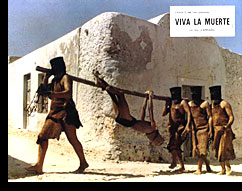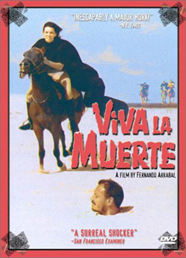| Release List | Reviews | Price Search | Shop | Newsletter | Forum | DVD Giveaways | Blu-Ray/ HD DVD | Advertise |
| Reviews & Columns |
|
Reviews DVD TV on DVD Blu-ray International DVDs Theatrical Reviews by Studio Video Games Features Collector Series DVDs Easter Egg Database Interviews DVD Talk TV DVD Talk Radio Feature Articles Columns Anime Talk DVD Savant HD Talk Horror DVDs Silent DVD
|
DVD Talk Forum |
|
|
| Resources |
|
DVD Price Search Customer Service #'s RCE Info Links |
|
Columns
|
 |
¡Viva la muerte!
|
||||
DVD Savant mostly reviews films from an entertainment point of view. ¡Viva la muerte! can hardly be called entertaining; it's a shock-political-poetic gauntlet of a film made by a famous exile from Franco's Spain, and it has scenes that are purposely disgusting and disturbing. It isn't quite the abomination that is Pier Paolo Pasolini's Salo, but it's a step in that direction. That said, ¡Viva la muerte! was critically acclaimed when it came out in 1970, a time when many openly revolutionary movies were circulating on the art circuit, like Alejandro Jodorowsky's El Topo.
Fernanado Arrabal is a well-known Spanish author, a surrealist who (at least in this movie) adds a shock factor to the already disturbing precedent of Salvador Dalí and Luis Buñuel, both of whom used film to make edgy anti-Fascist and anti-clerical statements. ¡Viva la muerte! is Arrabal's first movie and his most famous, although censorship has certainly made it more well-known than it might have been. If a political movie is supposed to bring about positive change, ¡Viva la muerte! doesn't qualify. Something tame like Norma Rae, with its pro-labor position, is a lot more potent than this unpleasant and sometimes disgusting film, which could easily be used by Spanish Fascists to prove that liberalism is decadent, blasphemous, and evil. ¡Viva la muerte! is more successful as anti-Fascist poetry, the filmic equivalent of a political prisoner retaliating in the only way he can, by screaming obscenities at his captors. 
Some genuinely horrible themes thread through ¡Viva la muerte!, all made more disturbing because they're communicated through the mind of an impressionable child. The titles are surreal ink drawings of Hieronymous Bosch-like horror, images of humans impaled and mutilated in disturbingly morbid ways -- buzzsaws cutting a man in half, rats pictured ready to eat a nude woman, etc. Every few minutes the picture switches to solarized color, or kinescoped video, for another of Fando's horrible visions. His mother first caresses his bound father, then gouges his eyes out with her long fingernails. And that's a tame example. The slight stylization of these scenes makes them more painful, as we're able to imagine traumatic details we can't clearly see. ¡Viva la muerte! also has a squeamish theme of aberrant sexuality. The disturbed Fando is seen biting the head from a lizard and helping his strange Aunt Clara by whipping her. His young girlfriend remains untouched and innocent, which would be a relief if it didn't make the rest of the show seem all the more misogynistic -- in this Spanish world of political madness, the virtuous and loving father is betrayed by church-crazed, politically fanatic and wholly Sadistic women. Literary praise for Fernando Arrabal is high, with critics of his written work comparing him to Cervantes. As a provocative political shock movie, Arrabal's first film is well-directed and suitably surreal without resorting to too many visual clichés. It's also nicely photographed and well acted. Just the same, it can only be recommended to two groups -- academically-minded aesthetes or the morbidly curious. In the face of all the torture, imprisonment and murder that was being undertaken by repressive governments in 1970, it's difficult to dismiss the methodology of a genuine political exile -- no other kind of film or media really gives a damn about these political abominations. Cult Epic's DVD of ¡Viva la muerte! is an excellent transfer from pristine materials obviously carefully hidden from the censors. The normal scenes look good in 16:9 nhancement, and the color-altered and strange video hallucination scenes are also well transferred. The soundtrack can be played in the original French or Spanish with removable English subtitles. The music is clear, especially a Dutch children's song that serves as a creepy counterpoint to the more outrageous & ugly scenes. The extras include a selection of stills and a series of short recent interviews with Fernando Arrabal. The author turns his interviews into a dada-ist performance act, talking in elliptical phrases that sound authoritative but don't express much about the film. To give you an idea of what the interviews are like, in one of them, he holds and turns a chair before him while talking to us. He gives away his act by reaching for a glass of wine at frequent intervals, however. Even though it's a Dalí- like stunt, it amply expresses what Arrabal's critics describe as his constant game-playing, a theme said to run through all his work. The provocateur presents the most seriously horrible subjects he can imagine, and then doesn't take them seriously.
On a scale of Excellent, Good, Fair, and Poor,
¡Viva la muerte! rates:
Review Staff | About DVD Talk | Newsletter Subscribe | Join DVD Talk Forum |
|
| Release List | Reviews | Price Search | Shop | SUBSCRIBE | Forum | DVD Giveaways | Blu-Ray/ HD DVD | Advertise |






